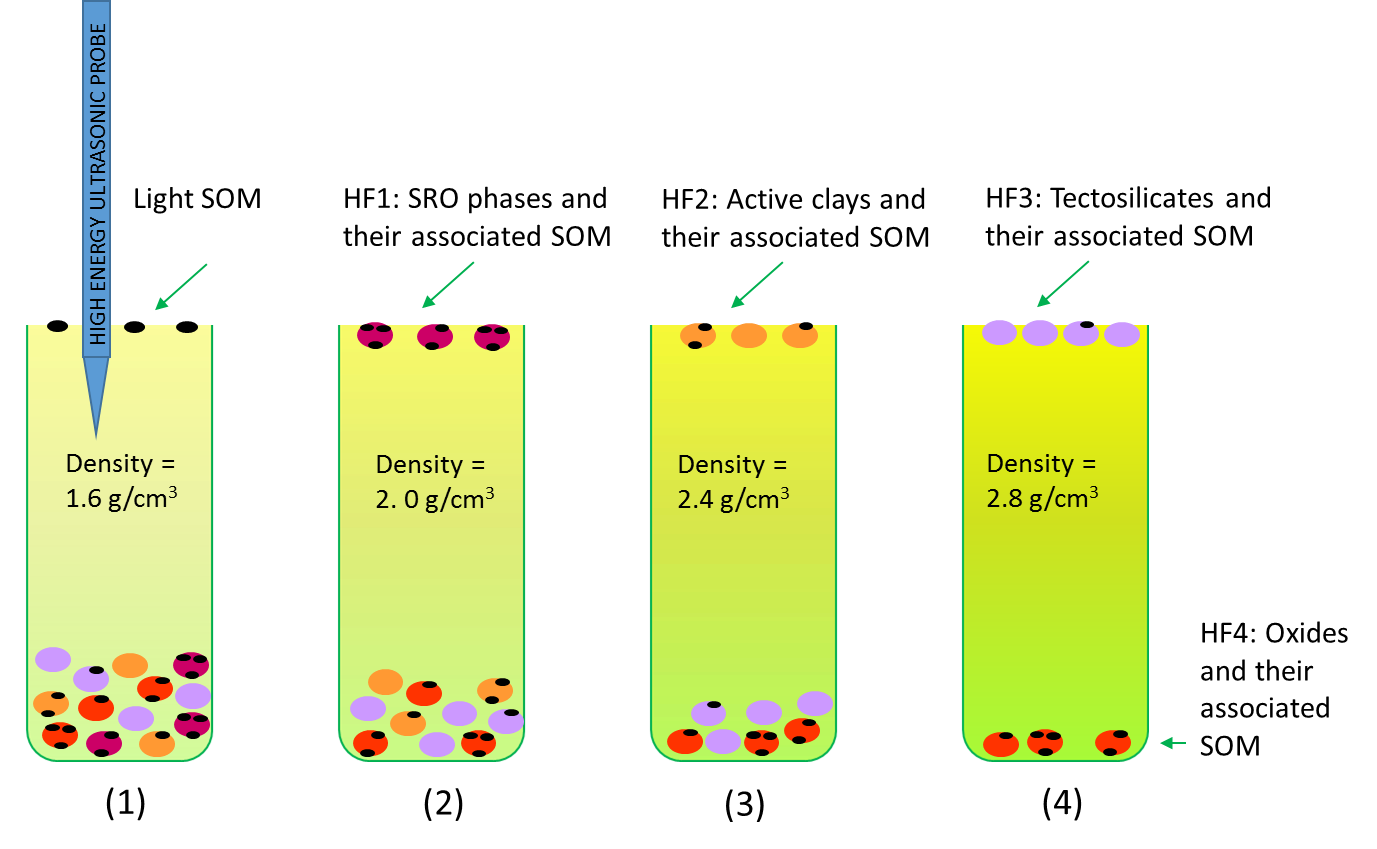Density Sollins 2
Description and working steps
This method is based on the work of Sollins et al. (2006; 2009). It aims to separate organic matter associated with minerals of different densities, and thus, different mineralogical composition. The aim is thus not only to separate the ‘light’ from the ‘mineral-associated’ organic fractions, as is done in simple density fractionation, but to resolve the heavy fraction into organo-mineral complexes of different mineralogy. Contrary to the original published works, we use similar density cut-offs across soil types to improve the ease of comparison.
In step 1 (Fig. 1), the soil sample is dispersed by sonication (selected energy in this study was 100 J/mL). The light fraction of soil organic matter (SOM) is separated from the mineral-associated fraction using a sodium polytungstate (SPT) solution of 1.6 g.cm-3 density.
In step 2, the heavy residue is re-suspended in a SPT solution of 2.0 g cm-3 density. The floating fraction (heavy fraction 1, HF1) represents complexes of organic matter and relatively light mineral phases, such as short-range order (SRO) phases. Dominant mineral components may include allophane (density = 1.9 g cm-3) and other amorphous or nanocrystalline aluminosilicates.
In step 3, the heavy residue is re-suspended in a SPT solution of 2.4 g cm-3 density. The floating fraction (heavy fraction 2, HF2) represents complexes of organic matter and mineral phases of intermediate density such as high-activity phyllosilicates (smectite density = 2.3 – 2.35 g cm-3).
In step 4, the heavy residue is re-suspended in a SPT solution of 2.8 g cm-3 density. The floating fraction (heavy fraction 3, HF3) is usually dominated by framework silicates such as quartz (density = 2.63 g cm-3) and feldspars (density = 2.52 – 2.74 g cm-3). In highly weathered soils such as those of the tropics, abundant kaolinite (density = 2.6 g cm-3) is also found in this fraction. It is often the fraction with the largest total mass and also the smallest organic loading.
The heavy residue from step 4 is enriched in oxides such as boehmite (density = 3.0 g cm-3), goethite (density = 3.8 g cm-3), lepidocrocite (density = 4.0 g cm-3) or hematite (density = 5.3 g cm-3).
Initial aim
Sequential density fractionation aims to separate mineral-associated organic matter into fractions differing in mineralogy.
Advantages
Different minerals have a different ability to sorb and stabilize soil organic matter. This method allows for the identification of the mineral phases most relevant to organo-mineral interactions in each soil.
Disadvantages
The procedure is long and rather delicate.
References
Sollins, P., Swanston, C., Kleber, M., Filley, T., Kramer, M., Crow, S., Caldwell, B.A., Lajtha, K., Bowden, R., 2006. Organic C and N stabilization in a forest soil: Evidence from sequential density fractionation. Soil Biol Biochem 38, 3313-3324.
Sollins, P., Kramer, M., Swanston, C., Lajtha, K., Filley, T., Aufdenkampe, A., Wagai, R., Bowden, R., 2009. Sequential density fractionation across soils of contrasting mineralogy: evidence for both microbial- and mineral-controlled soil organic matter stabilization. Biogeochemistry 96, 209-231.

